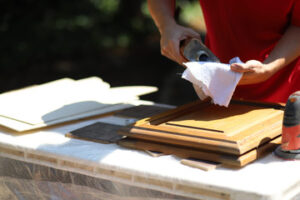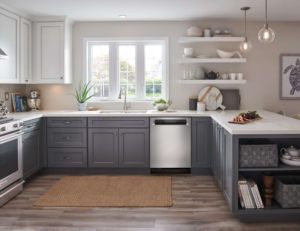The cabinets in your kitchen make a huge impact on the overall look and feel of the room. If they are old and outdated it may be time to consider cabinet refinishing.

But is it really worth it? Is this a cost-effective way to update your cabinets? Keep reading to learn more about San Jose Cabinet Refinishing.
Cabinet refinishing is a much more cost-effective option than refacing, and can save homeowners up to 50%. Refacing costs upwards of $5,500 on average and requires the demolition and installation of new cabinet doors and drawer fronts. Cabinet refinishing, on the other hand, typically costs no more than $1,500 on average, and is perfect for those who want to update their cabinets but don’t have the budget to replace them.
Before any work can begin, the cabinet surfaces will need to be prepped. This will involve stripping any existing paint, repairing any cracks or holes, and sanding the surfaces to prepare them for a fresh coat of stain or paint. If necessary, the cabinet boxes will also need to be repaired. This is a time-intensive project, and many homeowners find that they need to hire professionals for this job to ensure that the work is done properly.
The type of material used on the cabinet doors and drawer fronts will also impact the refinishing process. For example, thermofoil and laminate can’t be refinished, as they don’t have the proper substrate to hold the stain or paint. Solid-color cabinets, on the other hand, are usually made of medium-density fiberboard (MDF), which can be refinished. This is a good option for homeowners who don’t want to commit to replacing their kitchen cabinets, but would like a change in color.
Reusing hardware is another great way to save money on a cabinet refinishing project. If your existing hardware matches the new aesthetic, there’s no need to purchase new knobs and pulls, which can be expensive. Homeowners who are looking to save even more can opt to use polyurethane instead of solvent-borne lacquer when refinishing their cabinets, as this finish is less expensive.
While it is possible to refinish your cabinets yourself, the project is a huge undertaking and should be left to professional technicians with years of experience. It’s important to do your research when hiring someone for this task, and ask questions about their previous experiences with refinishing projects. Homeowners should also be sure to get multiple quotes from different contractors before making a decision.
Time-Saving
Cabinet refinishing involves working with existing doors and cabinets to change their color. This process is much faster and easier than replacing them with new ones. It’s also a more eco-conscious option since the original materials are reused, rather than discarded and end up in landfills where they can leach chemicals into soil and water.
Refinishing is a great choice if you’re looking to upgrade your kitchen without breaking the bank. But it’s important to know that this project can be difficult for DIYers. It requires a lot of work and a good understanding of the process. It’s also important to use proper prep and safety procedures, as improper handling of chemicals and sanding can cause damage that may be costly to repair.
To start, you’ll need a variety of tools and supplies. This includes a sanding machine and sandpaper, paint or stain, a sprayer or brush, a drop cloth, and protective gear such as masks and gloves. It’s also a good idea to have a helper to assist you with the heavy lifting.
Before you begin, it’s important to sand the cabinets and scuff them to give them “tooth” and promote adhesion. Make sure to sand the entire surface, including edges and corners. Once the sanding is complete, you can vacuum and tack the area to remove any residual dust. It’s also a good idea at this point to seal the cabinets with a high-quality primer, especially if you’re moving from a dark to light color.
Once the primer has dried, you can begin painting or staining. It’s a good idea to use a high-quality acrylic latex or enamel for best results. A good quality finish will protect the cabinets from daily wear and tear and will look great for years to come.
Refinishing is not as extensive as refacing, but it can be more time-consuming. The main difference between refacing and refinishing is that refacing involves removing the hinges, handles, and hardware from the cabinets, as well as sanding down the existing structures. A refacing job can be completed in a day or two, but it can take up to four days to complete a refinishing project.
Aesthetically-Appealing
Cabinet refinishing is an effective and cost-efficient way to revitalize your home’s appearance. This transformative process allows you to customize your living spaces with a fresh coat of paint or stain that aligns with current design trends and reflects your personal style.
The refinishing process begins with a thorough cleaning and degreasing of the cabinets, ensuring that the new finish will adhere seamlessly. This is a crucial step because if the cabinets are not properly prepared, it can lead to unsatisfactory results and premature wear and tear.
A professional cabinet refinishing company will strip the existing finish in order to prepare the wood for a new coat of stain or paint. This is done by using a chemical stripping agent or through lots of sanding. It is important that the existing finish is completely stripped so that the new coating will adhere properly. If the new coating does not adhere, it can cause sagging and chipping. It is also crucial that the new stain or paint used is formulated specifically for cabinetry. Regular paint bought in a store is not made to withstand the moisture that is found in kitchens and bathrooms, so it will begin to peel or fade quickly.
During the refinishing process, any cracks or chips in the cabinets will be repaired, and any water damage will be treated with appropriate drying and sanding methods. This will ensure that your newly refinished cabinets will be durable and beautiful for years to come.
Whether you are looking for a classic white finish or something bolder, there is a wide range of color options available. Many homeowners choose to contrast their upper and lower cabinets with complementary colors, creating a dynamic effect that can dramatically alter the ambiance of your space. Moreover, the choice of cabinet hardware is another element that can make or break the look of your space. From simple knobs and pulls to elaborate handles, there is a wide selection of styles to choose from. This makes it easy to find the perfect match for your unique space.
Easy to Do
Cabinet refinishing is an easy DIY project and it’s much more affordable than buying new cabinets. The key to a successful project is proper prep and planning. Start by protecting the surrounding surfaces with plastic sheeting or building paper (which is more eco-friendly). This will protect your countertops, appliances, table and chairs from dust and sanding during the process.
The next step is to sand the existing finish down to the raw wood. You can use either a hand-held sanding sponge or an orbital sander. Be sure to sand the edges of each cabinet and any nooks and crannies to make them smooth. Once you’ve sanded the cabinet, clean it with furniture cleaner or a designated stripper in a well-ventilated area. After you’ve cleaned the surface, sand it again with medium-grit sandpaper and then 180-grit sandpaper on the orbital sander to smooth it out. Then vacuum the cabinet and tack rag off all remaining dust.
When it comes to painting, it’s important to choose a high-quality paint and primer that’s made for cabinets. Using standard acrylic or latex paint will eventually peel and chip, especially in high-traffic areas. Also, be sure to apply several coats of paint and wait for each one to dry before applying another. It’s also a good idea to experiment with your colors on a piece of scrap wood before you commit to any final decision.
If you want to give your cabinets a darker look, staining is a great option. The staining process is more involved than painting, but it’s still relatively easy. You can buy staining kits at most home improvement stores, and you’ll need to follow the instructions for your specific type of cabinet. Once you’ve stained your cabinet, it’s a good idea to wipe it down with mineral spirits and then tack-rag off the residue. Once it’s dry, you can re-tack the cabinet and apply a protective varnish.
